
|   |

|   |
 e-mail: sunilkothari1933@gmail.com 90th year celebrations of legendary Vidooshaka P.K.G Nambiar April 8, 2020 On 1st March, at Ottapalam, P.K.G. Nambiar, the celebrated Koodiyattam artiste renowned for his role of Vidooshaka, was felicitated on his 90th birthday. Son of the legendary Koodiyattam maestro Mani Madhava Chakyar, he has played an important role in bringing Koodiyattam beyond borders of Kerala, close to North India and elsewhere, with his chaste Hindi commentary in the role of a Vidooshaka. 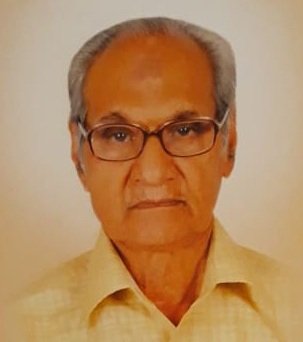 Hailing from an ancient family of Koodiyattam artistes, besides his special forte, the vachikabhinaya, he could excel equally in rasabhinaya too. A polyglot, PKG has through his Hindi version of the Vidooshaka verbiage, taken enchantment of Koodiyattam to many parts of India. This Hindi adaptation created the first awareness of the rich heritage of the art form in the higher echelons of art, which ultimately brought recognition from UNESCO as the 'Oral and intangible heritage of humanity.' PKG's Chakyar Koothu expositions have been suffused with humour as well as humanitarian messages. He has served the three forms of Koodiyattam, Chakyar Koothu and Padhakam with equal felicity. 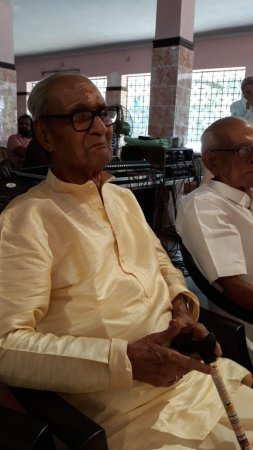 PKG 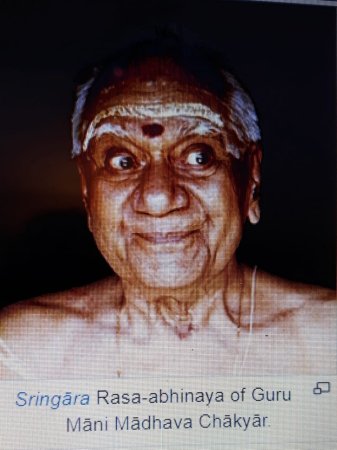 Mani Madhava Chakyar It was a privilege to be invited to this felicitation function and honour him. Way back in 1987 at Bhopal, his father Mani Madhava Chakyar had presented exceptional presentation through netrabhinaya of 'Shikhini shalabham' from Subhadradhananjayam, the like of which one rarely sees nowadays. Mani Madhava was able to act in detail the moths falling in and out of the lamp by evoking through eyes, assigning different rasas for female moth and the male moth and the fire! Present were late Habib Tanveer, Vijaya Mehta and a galaxy of theatre directors who were spellbound watching his abhinaya. PKG's daughter Jyoti, a Bharatanatyam dancer having received training from Kalakshetra, showed me a photo in which I am framed along with Dr.V.K. Narayana Menon surrounding Mani Madhava Chakyar in awe and admiration. I have been fortunate having seen him perform earlier at Delhi in 1974 and '79. His fame as an exceptional Koodiyattam exponent had spread far and wide. He even taught netrabhinaya to Kalamandalam Krishnan Nair and other artistes at Kerala Kalamandalam. It was said that he gave eyes to Kathakali, as the netrabhinaya invested the Kathakali form with extra dimension. PKG Nambiar from a very young age, recited Sanskrit shlokas running to the banks of Nila River at Killikurissimangalam, Lakkidi village, imitating even interpretation of his father. The strong passion for vachikabhinaya resulted into Padhakam. He was persuaded to present it at a temple near Irinjalakuda when Mani Madhava Chakyar accompanied him on mizhavu for Mantrankam play. PKG had not only received training in mizhavu playing but he was also taught Sanskrit by great masters. He passed intermediate examination in Sanskrit from Madras University. Then there was no looking back. During the freedom movement, PKG studied Hindi with great zeal and also mastered Prakrit, Urdu, and English. As a Hindi teacher, he served for 36 years at NSS High school. So popular was he as a teacher, that on the morning of the celebrations, I saw an unending stream of his students and admirers coming to greet him and touch his feet!  Vidooshak by PKG Nambiar  Natyakalpadruma by Mani Madhava Chakyar During the heydays of Koodiyattam, Mani Madhava Chakyar's troupe consisted of the trio Madhava Chakyar for veshams, Nambiar's elder brother for playing mizhavu and PKG Nambiar as Vidooshaka. His renderings in Hindi across the country made Koodiyattam accessible to public at large. That is the great service PKG has rendered. He also wrote a book in Malayalam, Vidooshaka Kudiyattatile Narma Sachivan which contains in detail the various rituals which are conducted during the play and order of performance. The subtle difference in the roles of Vidooshaka in plays like Naganandanam, Mantrankam, Swapnavasavadattam, Subhadradhananjayam are brought out in succinct manner by PKG. The revolutionary step taken by Mani Madhava Chakyar to take Koodiyattam from temple to stages outside in villages, towns and cities was much criticized but thanks to his enthusiasm to make the art known to public and PKG's speaking in Hindi has been a great boon for the art and for the rasikas and connoisseurs. When they performed at Benares Hindu University, the chaste Hindi that PKG spoke in role of Vidooshaka impressed the Vice Chancellor Bhagavaty who said that at this rate people from Benaras will have to go and learn such Hindi from the South! Mani Madhava was honoured, though late, by the Central Sangeet Natak Akademi; other honours were showered upon him with Suvarna shrinkhalas and later on the Kerala Sangeet Natak Akademi woke up to honour with him an award. PKG's services were taken by Song and Drama Division for conveying messages for removing curse of untouchability, family welfare, national integration and prohibition. PKG has written few Prabandhas used in Koothu like Prahlada Charitram, Bhattarakavijayam and Shakuntalam. He has translated Natyakalpadruma authoured by his father in Malayalam into Hindi and written in Hindi, a book on Vidooshaka published by Sangeet Natak Akademi. 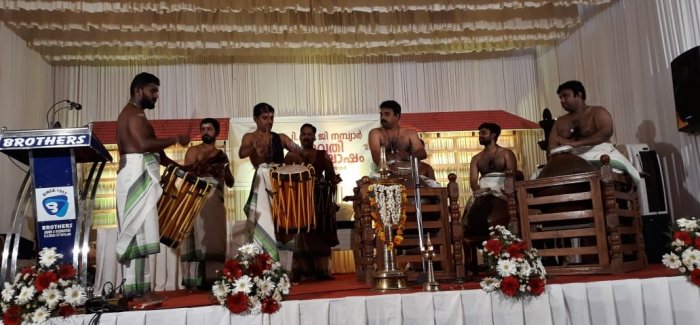 Mizhavu-chenda jugalbandi During the felicitation, a special Mizhavu Thayampaka was arranged in the morning by Mani Madhava Chakyar Gurukulam. It was a fascinating jugalbandhi between three mizhavu players and three chenda players challenging each other with intricate talas. The sheer energy with which they were pounding on the mizhavu also known as Pani vadyam, as the drummers play with palm and the chenda players with the sticks on chenda and the talam with cymbals, was amazing. One almost got mesmerized at their art of percussion playing. In the afternoon, PKG's nephew Sreeraj presented Chakyar Koothu displaying the art he has inherited from his uncle. The commentary in Malayalam rendered with recitation in-between Sanskrit shlokas was in keeping with the tradition. His brother played on mizhavu. PKG told me that he has been training them as they have shown keen interest in keeping the art alive in the family. 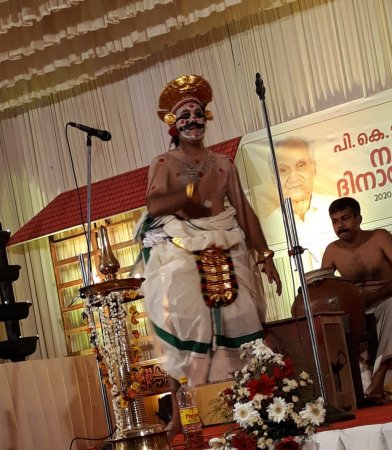 Chakyar Koothu by Sreeraj The two granddaughters Aparna and Saranya trained in Kalakshetra and also under their mother Jyoti, presented brief items of Kavutvam and Kirtanam. They have inherited large eyes and ability to express through eyes, the rasas as descendents of Mani Madhava Chakyar. Later on, one young student rendered classical music and ashtapadi from the Gita Govinda. The felicitations by the veteran contemporaries including advocate PT Narendra Menon, Prof George S Paul, V.K. Sreekandan (Member of Parliament), Sukumari Narendra Menon, renowned art critic Vijaykumar Menon were heartwarming and drew attention to PKG's lifelong services to the art. In replying as a special gesture, PKG after thanking all, recited a shloka and explained in Hindi for my benefit its meaning as a Vidooshaka would in the play with abhinaya which was indicative of his glorious vachikabhinaya. The story runs as follows: Every morning, King Bhoja when waking up would see through the window, auspicious omens and things. Once while watching, he saw a Bhukund, a washerman of low caste and turned his face away quickly. While doing so, his head was hurt and started bleeding. He summoned his servant and ordered him to bring Bhukund and have him beheaded. Bhukund politely begged forgiveness and said: "O king! Today as per the order of the word Bah, Bah, Bah, Bhi, Bee, and in the end from Bah to Bhukund, you have asked your servant to behead me. But remember tomorrow as per the order of the word, there will be Bhupati, meaning you; it will be your turn to die. Death will be for all. It will embrace King and a pauper." Listening to Bhukund's statement, the King understood that he was doing injustice to Bhukund and realized that death will treat one and all as equal. He embraced Bhukund and gave him an honourable place in his court. I was quite overwhelmed. It was indeed a privilege to witness his art when he was turning 90 and had the same zeal to render with such energy.  Dr. Sunil Kothari is a dance historian, scholar, author and critic, Padma Shri awardee and fellow, Sangeet Natak Akademi. Dance Critics' Association, New York, has honoured him with Lifetime Achievement award. Post your comments Please provide your name and email id when you use the Anonymous profile in the blog to post a comment. All appropriate comments posted with name and email id in the blog will also be featured in the site. |